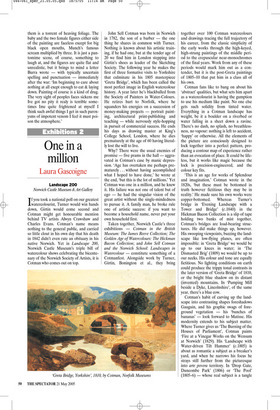One in a million
Laura Gascoigne
Landscape 200 Norwich Castle Museum & Art Gallery
If you took a national poll on our greatest watercolourist, Turner would win hands down, Girtin would come second and Cotman might get honourable mention behind TV artists Alwyn Crawshaw and Charles Evans. Cotman’s name means nothing to the general public, and carried so little clout in his own day that his death in 1842 didn’t even rate an obituary in his native Norwich. Yet in Landscape 200, Norwich Castle Museum’s triple bill of watercolour shows celebrating the bicentenary of the Norwich Society of Artists, it is Cotman who comes out on top. John Sell Cotman was born in Norwich in 1782, the son of a barber — the one thing he shares in common with Turner. Nothing is known about his artistic training, if he had one, but at the tender age of 20 we find him in London stepping into Girtin’s shoes as leader of the Sketching Society. The following year he makes the first of three formative visits to Yorkshire that culminate in his 1805 masterpiece ‘Greta Bridge’, which has been called the most perfect image in English watercolour history. A year later he’s blackballed from the Society of Painters in Water-Colours. He retires hurt to Norfolk, where he squanders his energies on a succession of money-making projects — portrait painting, architectural print-publishing and teaching — while nervously style-hopping in pursuit of commercial success. He ends his days as drawing master at King’s College School, London, where he dies prematurely at the age of 60 having literally lost the will to live.
Why? There were the usual enemies of promise — five prams in the hall — aggravated in Cotman’s case by manic depression. ‘Age has overtaken me perhaps prematurely ... without having accomplished what I hoped to have done,’ he wrote at the end, ‘but this is the lot of millions.’ Yet Cotman was one in a million, and he knew it. His failure was not one of talent but of ego — he had the singular vision of the great artist without the single-mindedness to pursue it. A family man, he broke rule one of artistic success: if you want to become a household name, never put your own household first.
Taken together, Norwich Castle’s three exhibitions — Cotman in the British Museum: The James Reeve Collection; The Golden Age of Watercolours: The Hickman Bacon Collection; and John Sell Cotman and the Norwich School: Landscapes in Watercolour — constitute something of a Cotmanfest. Alongside work by Turner, Girtin, Bonington et al., they bring together over 100 Cotman watercolours and drawings tracing the full trajectory of his career, from the classic simplicity of the early works through the high-keyed, high-strung paintings of the middle period to the crepuscular near-monochromes of the final years. Work from any of these periods would mark him out as a contender, but it is the post-Greta paintings of 1805–10 that put him in a class all of his own.
Cotman fans like to bang on about his ‘abstract’ qualities, but what sets him apart as a watercolourist is having the gumption to use his medium like paint. No one else gets such solidity from tinted water. Everything in a Cotman landscape has weight, be it a boulder on a riverbed or water falling in a sheet down a ravine. There’s no dash, no splash, no breathlessness, no vapour: nothing is left to accident, ‘happy’ or otherwise. All the elements of the picture are consciously designed to lock together into a perfect pattern, producing a contour map of experience rather than an evocation of place. It could be lifeless, but it works like magic because the lock is precision-engineered, and the colour key fits.
‘This is an age for works of Splendour and imagination,’ Cotman wrote in the 1820s, ‘but these must be bottomed in truth however fictitious they may be in reality.’ He made sure his own works were copper-bottomed. Whereas Turner’s bridge in ‘Evening Landscape with a Tower and Bridge’ (c.1840) in the Hickman Bacon Collection is a slip of tape holding two banks of mist together, Cotman’s bridges are load-bearing structures. He did make things up, however. His swooping viewpoints, buzzing the landscape like low-flying planes, are often impossible: in ‘Greta Bridge’ we would be up to our knees in water; in ‘The Dismasted Brig’ (1809) we would be up to our necks. His colour and tone are equally fictitious. No lighting conditions on earth could produce the trippy tonal contrasts in the later version of ‘Greta Bridge’ of 1810, or the bright blue shadow on its distant (invented) mountains. In ‘Pumping Mill beside a Dyke, Lincolnshire’, of the same year, there’s a blue cow.
Cotman’s habit of carving up the landscape into contrasting shapes foreshadows Gauguin, and his graphic swags of foreground vegetation — his ‘bunches of bananas’ — look forward to Matisse. His modernity extends to his subject matter. Where Turner gives us ‘The Burning of the Houses of Parliament’, Cotman paints ‘Fire at a Vinegar Works on the Wensum at Norwich’ (1829). His ‘Landscape with Water-driven Tilt Hammer’ (c.1805) is about as romantic a subject as a breaker’s yard, and when he narrows his focus he strays still further from the picturesque into arte povera territory. In ‘Drop Gate, Duncombe Park’ (1806) or ‘The Pool’ (1805–6) — whose real subject is a tangle of driftwood — we see Constable’s ‘old rotten planks’, without the sentiment.
In art, timing is everything, and Cotman got his wrong. Cursed with a classical eye in a romantic era, he was both behind the times and ahead of them. In his day he looked old-fashioned; now he looks modern. In fact his art is timeless because, being ‘bottomed in truth’, it was built to last.
Cotman in the British Museum and The Golden Age of Watercolours continue until 26 June; John Sell Cotman and the Norwich School until 19 March 2006.


























































 Previous page
Previous page